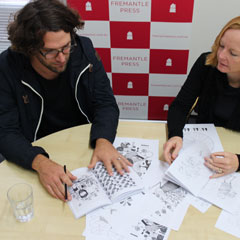Creating a picture book

Children’s publisher Cate Sutherland discusses the trials and the triumphs of publishing children’s picture books.
The most common misconception about picture books is that because they are short and written for children they must be easy to write.
That’s not the case. Picture books are closer to poetry writing than to novel writing. They must use language in a beautiful way and, with only 120 to 700 words to play with, they must tell stories economically.
For me, picture books always start with the story – that goosebumps moment when I read something in the submission pile that excites me. There are no illustrations at this stage and acceptance to the Fremantle Press list relies principally on the written word.
Pairing an illustrator with a writer is my favourite part of the process. I love visualising what the story could look like depending on which illustrator does the work. The choice of illustrator completely changes the final book.
Illustrating a book starts with a conversation. The author has to feel that the illustrator is right and the illustrator has to be inspired by the story. Sometimes an illustrator will have a very clear idea about how the book might look. They might ‘see’ a landscape illustration which then helps us determine the book’s format. But it’s not entirely up to them. We consult with sales and marketing to get the right format for the audience and we also have to make sure that the book’s budget balances!
The author works on the text while the illustrator comes up with character sketches, mood boards, a colour palette and a storyboard. It’s my job to look at the balance between single pages and spreads, how the text will fit on the page, consistency of character, the perspective used and whether the visual story flows.
The author and I discuss sound and rhythm. Most picture books are read aloud, and the text has to work regardless of who is doing the reading. At this stage we also pare back the text because the illustrations start to take on the storytelling and one needs to enhance the other without repetition.
Just when you thought three was a crowd: I brief the designer. The designer sees and comments on the storyboard. They highlight potential problems, make suggestions and make the all-important font selection. Feedback to the illustrator at this stage is crucial. The illustrator only starts the final artworks after the storyboard is signed off.
Illustrators like Brian Simmonds, Moira Court, Ambelin Kwaymullina and Kyle Hughes-Odgers will submit their artwork on paper, art board, linen or canvas whereas James Foley, Chris Nixon and Sean E. Avery are more likely to provide digital works. Non-digital artworks are photographed and sent to the designer to lay out. The designer will also create the cover – sometimes from cover-specific artwork, sometimes from an internal piece or sometimes using elements of many pieces.
The text is proofed and proofed and proofed again and again and sometimes again and then the final pages are approved by the author and the illustrator and sent to print. The anxious wait for proofs from the printer begins. The proofs are our final opportunity to check everything is okay. Once approved, the book heads to the presses.
It takes a couple of months for the books to be printed, dried, trimmed and bound then packed, quality-checked and delivered. We allow at least six to eight weeks. But the wait is always worth it! I love seeing the finished product and so do the creators. We hope you do too.


